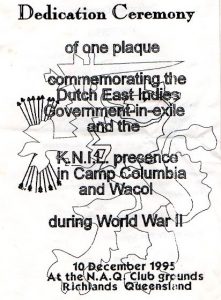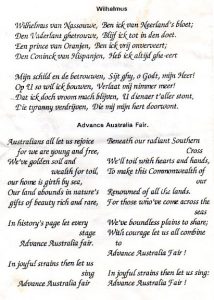Dutch continued to use Camp Columbia after the war
The Dutch planned to stay in Camp Columbia until the Australians had liberated sizeable towns in the NEI, so Dutch officials could start establishing administration and started with reestablishing Dutch institutions services and political power. Once Dutch officials could go back people from these liberated towns could provide relief to across all NEI organisations. As no such large population centre were liberated, the NEI government-in-exile remained at Wacol until War’s end in September 1945. They were hampered to return by the Black Armada Boycott. As the situation in Indonesia remained violent because of the Bersiap. This is the name given by the Dutch to a violent and chaotic phase of the Indonesian National Revolution following the end of World War II. The Indonesian word bersiap means ‘get ready’ or ‘be prepared’. The Bersiap period lasted from August 1945 to November 1947.
However, slowly Dutch official went back to NEI but Camp Columbia remained in use by the NEI Government until March 1946. After the Japanese surrendered, the Dutch phased the problem of 100,00- civilians, manlily women and children locked up in Japanese camps, Those people that were close to starvation or were otherwise in ill health needed immediate care. Australia accepted 5000 people who were able to recoup in Australian for 3 to 6 month. Camp Columbia was used as one of the places that accepted those refuses. For that reason part-use of Camp Columbia continued into 1947. Some barracks and houses were used for recuperation . There are newspaper articles about the evacuation from Dutch people liberated from the Japanese camps in Netherlands east Indies. They were underfed and needed medical attention. Article is in Dutch. Dutch Newspaper articles 1945.
A large number of Dutch people stayed in Australia or after a forced return to the Netherlands emigrated back a few years later. When in 1957 Indonesia nationalised Dutch companies and ordered 50,000 Dutch people to leave the country, again many people emigrated to Australia. Some were housed in parts of the previous Camp Columbia that now had become the Wacol Migration Centre.

 By the 1980s the converted timber Army huts were aging and a different model for receiving immigrants was evolving. The Wacol Migrant Centre was closed in 1987. The Prisons Department took over the site and the Arthur Gorrie Correctional Centre was opened in 1992.
By the 1980s the converted timber Army huts were aging and a different model for receiving immigrants was evolving. The Wacol Migrant Centre was closed in 1987. The Prisons Department took over the site and the Arthur Gorrie Correctional Centre was opened in 1992.
A few of the old Wacol Military Barracks have since been converted into the Wacol Military Museum. The Nissan Hut ( Igloo) has been transferred possibly from the hospital site (After the war the site was occupied – from 1950 till 1973 – by the New Guinea Volunteer Rifles & Papua New Guinea Volunteer Rifles ex-members Association. In 2006 some of the buildings were earmarked for preservation and are now part of a military museum)
